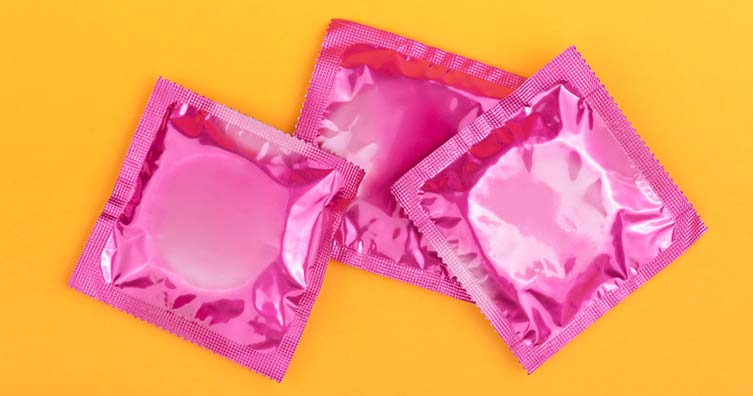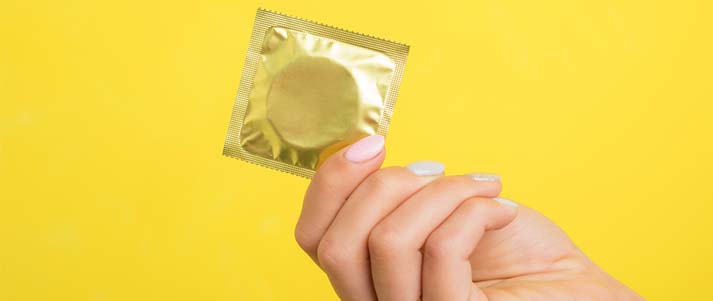How to get a free STD or STI test
Getting tested for sexually transmitted infections (STIs) when you're at university is really nothing to be embarrassed about. It's a super simple process and sometimes it's free!

Credit: Dmytro Khlystun – Shutterstock
Condoms are your best bet for protection when having sex, particularly when doubled up with another form of contraception, but sometimes things don't go to plan. Even when you've been taking precautions, it's always better to get an STD or STI check if you're sexually active.
Chlamydia's one of the most common STIs, and the NHS recommends sexually active people under the age of 25 get tested for it every year or when they change sexual partners.
Don't bury your head in the sand. Getting an STI test at uni is easy, free and can even be done at home if you'd prefer. Read on to find out how.
What's in this guide?
When should you get tested for an STI?

Credit: Kaspars Grinvalds – Shutterstock
Here's all you need to know about when you should get an STI test and why it's important to do so even if you haven't got any symptoms.
What's the difference between an STI and an STD?
STI stands for 'sexually transmitted infection' and STD stands for 'sexually transmitted disease'. Effectively, the difference is in the name.
A disease occurs when a foreign presence negatively affects and disrupts the body's normal function. An infection is when a bacteria or virus invades the body and starts to multiply. However, infections don't always cause external symptoms.
Not all sexually transmitted diseases begin with sexually transmitted infections, but many do, and an STI may progress into an STD if left untreated.
It's worth keeping in mind that carriers of STIs can show absolutely no symptoms of infection. This is why it's important to get tested after you've had unprotected sex, even if you aren't showing any external signs of infection.
When do you need to get tested for an STI or STD?
You should get tested when you've had unprotected sex of any kind (vaginal, anal or oral). You can pick up an STI from having any kind of unprotected sex, and this also goes for genital contact and sharing sex toys.
As we've said previously, you may not even realise you've got an STI as symptoms don't always show. But, if left untreated, they can be uncomfortable, painful and cause long-term damage to your health or fertility. What's more, you could pass them on to someone else.
Thankfully, most STIs can be very easily treated – but it all hinges on you taking the test first. You should never feel embarrassed about taking care of yourself, but if the idea of taking a trip to the clinic makes you flush, you can test yourself at home.
How soon can you get tested for an STI?

Credit: samritk – Shutterstock
If you have unprotected sex, you'll probably want to get tested ASAP to find out about any infections early. But while this is obviously a good attitude to have, you're actually better off waiting a couple of days before first getting tested.
It can take a while for STIs to show up on test results as they all have different window periods (i.e. how long it takes tests to pick them up after you've been exposed to them).
For some STDs, it can only take a couple of days to show up on a test, but for others, it can take weeks or even months. It's best to take an STD test a few days after having unprotected sex, and then again a few weeks later.
How long should you wait to get tested for STIs and STDs?
Here's a list of the main STIs and how long it can take each one to show up on a test:
- Chlamydia – Up to two weeks
- Gonorrhoea – Up to two weeks
- HIV – Four to 12 weeks
- Syphilis – Up to 12 weeks
- Hepatitis B – Up to 12 weeks
- Hepatitis C – Up to six months
- Genital herpes – You can get tested when visible blisters or sores appear (but it could take months or even years for symptoms to show).
Getting an STI test at university
There are a few places you can get tested for STIs, including your local GP surgery and GUM clinics.
GP surgeries and sexual health clinics
Many GP surgeries offer STI testing – but not all. The easiest way to find out is to ring up and ask. If you've changed GPs since starting at uni to one in your university town, ring up your new GP to find out.
If they do offer STI testing, they'll book you in for an appointment. If not, they'll direct you towards the nearest service which does.
This will normally be in the form of a sexual health clinic or GUM (genitourinary medicine) clinic, which are just like your local doctors but they specialise in sexual health.
Visiting your doctor or a sexual health clinic is the easiest way to get a free STI test. In some cases, the service might even be on campus, so you won't have to travel far. Your university may have a page on sexual health resources for students, so that may be a good place to start when finding out about services in your area.
Remember to visit after any time you have unprotected sex. Don't wait around for your yearly check-up if you have any doubts!
What happens when you get tested?
Whether you're at your local GP or a sexual health/GUM clinic, your STI test will go something like this:
- You'll be able to request to be seen by a male or female doctor/nurse, but you may have to wait slightly longer for one to become available.
- You'll be asked to answer some questions about yourself, your medical history and your sex life on a form. This is essentially used to determine how at-risk you are of contracting certain infections.
- If you're testing for chlamydia or gonorrhoea, this will involve a urine sample (for males) or a self-taken vaginal swab (for females). Testing for HIV and syphilis needs a blood sample. Herpes isn't usually tested for unless you show symptoms such as sores, in which case swabs of the sores will be taken.
- Depending on which test you've done, results can be provided on the same day, or can take one to two weeks. It will be made clear to you on the day how long you'll have to wait for results, and they'll ask you how you would prefer to be contacted (e.g. via text).
- If you test positive for an STI, you'll be invited back to the clinic for treatment.
Where to order home STI and STD tests
One of the main reasons people are put off getting an STI test is the stress and hassle of going to your GP or local sexual health clinic. But, the good news is you can now test for some STIs from home.
As part of our useful resources for students, we've put together a list of some of the main STI home testing services available. Some are free but others aren't, so check the eligibility criteria carefully before ordering an at-home STD test:
-
NHS chlamydia test

Cost: FREE
If you're under 25, the NHS offers free home testing kits for chlamydia. You can type in your postcode and follow the links to the relevant site.
Remember, these tests are for chlamydia only. You'll need to order other home test kits or visit your GP to test for other infections.
-
SH:24

Cost: FREE (in some areas)
This service allows you to test for chlamydia, gonorrhoea, syphilis and HIV for free, all from home.
They'll send the test to you in a plain, discreet envelope and provide everything you need to post your urine sample to the lab.
They'll also communicate with you via text to update you on the progress of your sample and to let you know your results.
It's currently available in more than 40 areas. If they don't currently cover your area but you'd still like to receive a test, try Fettle.
-
Sexual Health London (SHL)

Cost: FREE
If you live in London, you'll be pleased to know that the NHS has implemented an e-service providing access to sexual health testing over the internet.
SHL is available to people aged 16 and over who are residents in most Boroughs of London, except Hillingdon, Croydon and Greenwich.
You can order home tests for chlamydia, gonorrhoea, HIV, syphilis, hepatitis B and hepatitis C, which will be posted to you for free. You then send back your samples (also for free) and will get the results via text or email a few days later.
-
Fettle

Cost: £23 – £31 per test
If you don't live in one of the areas covered by SH:24 or Sexual Health London and can't get a free test from them, you could use Fettle instead. However, the service is not free and you'll have to fork out a bit for the tests you need.
You can get tested for chlamydia, gonorrhoea, syphilis, HIV, hepatitis B and hepatitis C, but they are priced individually between £23 and £31 per test (or as a six-test bundle for about £121). There are quite a few Fettle discount codes online though, so it's worth having a look before placing your order.
They offer a super-fast service. They'll send the test to you by first-class Royal Mail in a discreet envelope and will get your results to you within 72 hours of receiving your samples.
-
Terrence Higgins Trust

Cost: FREE or £15
If you're worried that you've contracted HIV, you can order a home HIV testing kit from the Terrence Higgins Trust.
Just pop your details in and they'll post the kit to your house. Unlike other STI home testing kits, you don't need to send your sample off to the lab.
Just follow the instructions with the test and you should be able to read the results for yourself within 15 minutes.
It'll set you back £15, but this is around half the retail price, and they do have some free kits set aside for people who are unable to afford them, as well as eligible individuals in certain areas of the UK.
The HIV window period with a self-testing kit is three months, but it can sometimes be detected as early as four weeks at a clinic.
If you think you may have been exposed to HIV less than three months ago, they still suggest testing early. However, they say you should test again three months after the exposure if the test result is negative or get tested at a sexual health clinic.
This is not an exhaustive list, and other STI home testing services might be available in your local area. Look online to see if there are any other options available to you.
How to do an at-home STD test
Home testing kits are super straightforward and they'll come with clear instructions on what to do.
If you're testing for chlamydia and gonorrhoea, you'll likely have to take a vaginal swab (if you're female) or pee in a pot (if you're male).
Or, if you're testing for HIV or syphilis, you'll have to take a blood sample which usually involves pricking your finger to draw blood.
Although it's easy enough to do, some people may feel queasy or uncomfortable doing it, in which case it might be best to ask someone to help you or visit your GP instead.
STI symptoms and how to treat them

Credit: Y Photo Studio – Shutterstock
It's easy to get confused as there are a few different STIs. Each has its own characteristics and methods of treatment.
If you're looking for a bit more info on what to expect before heading for your check-up, here's our list of the main STIs to look out for:
-
Chlamydia
What are the symptoms of chlamydia?
Most people don't know they have chlamydia as its symptoms don't appear in around 70% of women and 50% of men. That's one of the reasons why it's important to get regular checks.
However, symptoms may include pain when you pee, or an unusual discharge. Women might bleed between periods or experience pelvic pains, while men sometimes experience pain in their testicles.
Chlamydia can cause problems with fertility and pregnancy in later life.
How do you get tested for chlamydia?
A chlamydia test is pretty easy and can be done with a free at-home STD test or at a clinic. If you're a male, it involves peeing in a pot and if you're a female you need to get a vaginal swab.
How is it treated?
A simple course of antibiotics.
-
Gonorrhoea
What are the symptoms of gonorrhoea?
A large proportion of people won't show any symptoms of gonorrhoea, but you might experience pain or tenderness in your abdominal area for females, or in the testicles for males. You could also feel burning when you pee or get an unusual discharge.
Like chlamydia, gonorrhoea causes problems with fertility and can be very painful.
How do you get tested for gonorrhoea?
Men will need to wee in a pot and women will have a swab taken from their vagina.
How is gonorrhoea treated?
An antibiotic injection or tablets.
-
Genital herpes
What are the symptoms of herpes?
With genital herpes, you could find yourself feeling quite flu-like, along with small fluid-filled blisters around the genital/anal area, on the buttocks or the top of your thighs. These will burst but leave red sores which can be painful.
How do you get tested for herpes?
If you're being tested for herpes, you'll have to go and see a doctor so they can examine the blisters in person. They'll also take a swab to confirm their diagnosis.
You can pay for herpes tests online, but as they can cost around £80, we say stick with the clinic.
How is herpes treated?
Sadly, you cannot cure herpes, but taking courses of antiviral tablets will help to control the symptoms.
-
Syphilis
What are the symptoms of syphilis?
Syphilis is easily noticeable by sores which can appear anywhere on the body and can take up to six weeks to heal. They will usually appear in the genital area.
While syphilis is nowhere near as common as some other STIs, if left untreated for long enough, it can lead to serious damage to the heart, brain, bones and nervous system, even leading to loss of life.
How do you get tested for syphilis?
This one really is a 'go to the clinic' situation. You'll be given an examination by a professional and you'll need to take a blood test as well.
How is syphilis treated?
Thankfully, the treatment for syphilis involves antibiotic injections, tablets or capsules.
Of course, this list is not exhaustive. You've probably heard lots about HIV, genital warts and pubic lice (crabs) to name a few. It's just as important to get checked out for these too.
Chat with your GP or have a look at the NHS website if there's anything more you'd like to know.
Looking for casual hookups or something more serious? Check out our guide to the best dating sites and apps – just remember to stay safe!








